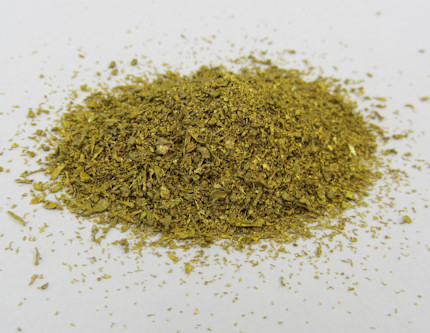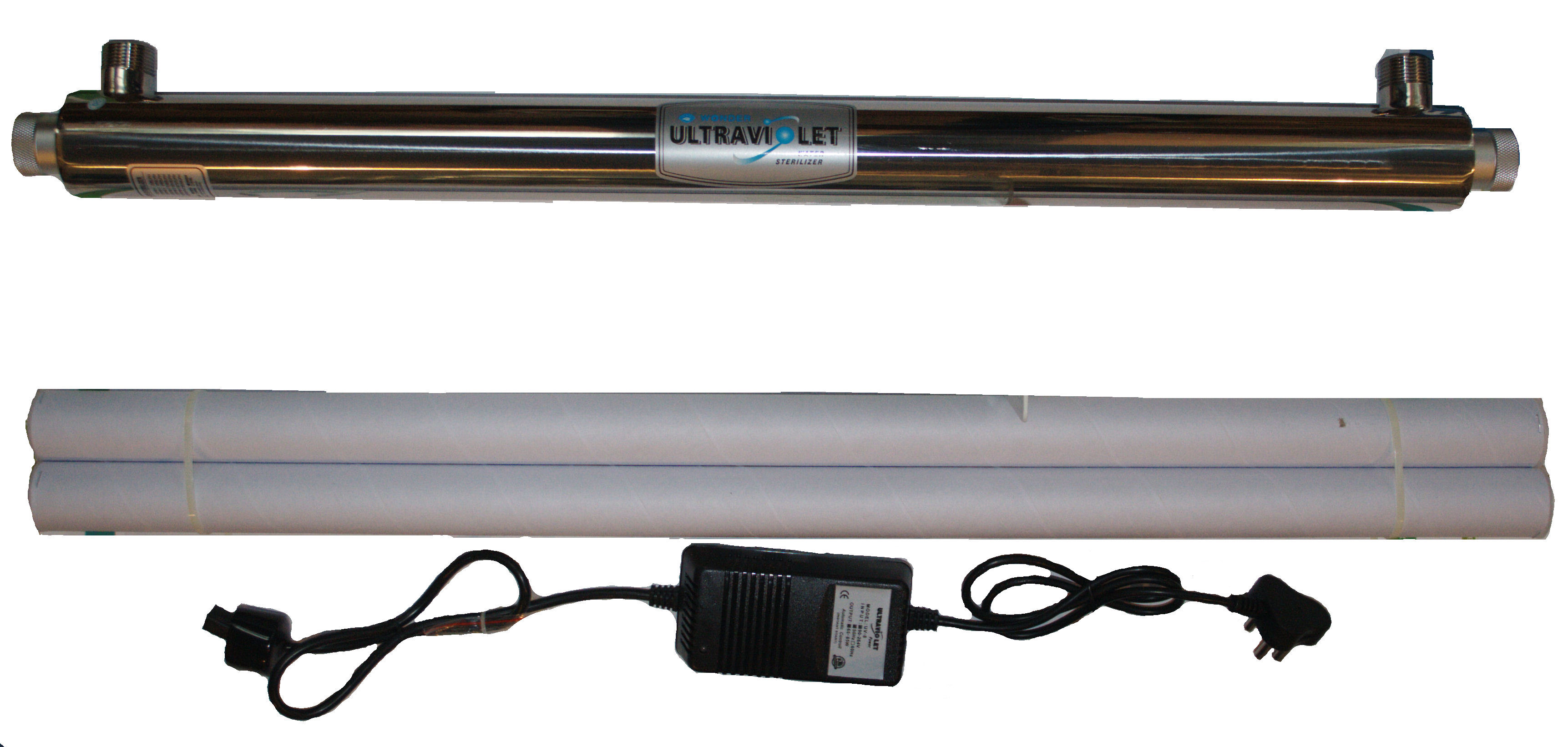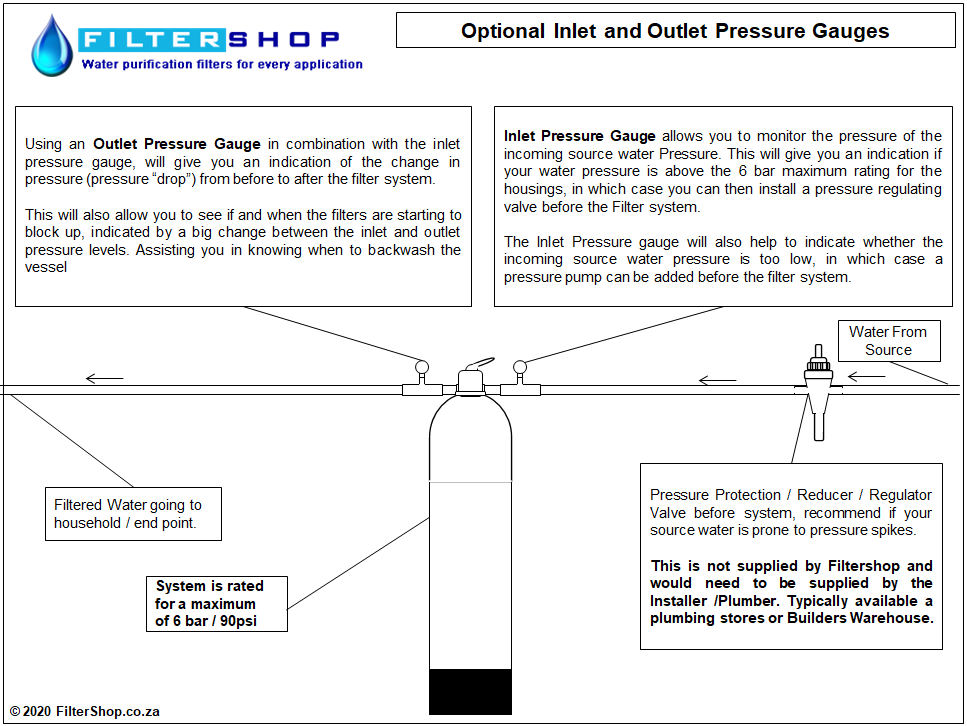Activated Carbon Filter Vessel (MegaChar)
The Activated Carbon Vessels (sometimes referred to as Mega Char systems) like a sand filter is used as a basic sediment filter, removing large particles from water such as dirt, sand, mud, rust and other large sediments, however the granulated Activated carbon also absorbs chlorine and organic molecules from the water making it smell and taste better.
- The domestic Carbon Vessel would be installed on the mainline of the household, and filter all the water going into the house.
- The Activated Carbon Vessels are available in 4 sizes ranging from 25 to 100 Litre, keep in mind that the large the Activated Carbon Vessel the more effective it will be at absorbing chlorine and the less often you will need to backwash the vessel.
The Deep bed carbon filter needs to be flushed on a regular basis (Typically once every 2 to 5 days, depending on the quality of the water source), to remove the sediment and particles trapped inside the vessel.
- The Domestic Carbon Vessel is not recommended for non-municipal source waters (for example boreholes) unless there are bad odors and smells in the water.
Benefits:
- All the water supplied to your house is filtered
- Removes chemicals such as chlorine
- Filtrated water tastes and smells great
- Preserve the natural minerals in the water
- No water wasted during filtration
- Low maintenance
- Relatively low maintenance cost
- No electricity required (with standard manual valve)
- Large filtration capacity.
- Low-cost filtration solution
Keep in mind:
- The Vessel needs to be flushed on a regular basis to prevent blockage of the units, this can be done manually or automatically with the Digital Backwash Valve.
- The domestic Carbon Vessel does not remove bacteria and other micro-organisms that may be in the water. If the water quality in your area is a real problem, you may want to consider a more advanced filtration adding a 1 Micron and Ultra Violet Light with carbon vessel.
- Minerals and pesticides are too small to be removed by the Domestic Carbon Vessel
- You will require some plumbing knowledge and experience to install the system successfully.
- This system is designed for the filtration of municipal water. If you make use of a different water source, such as a borehole, please contact us for advice on the right systems for boreholes.
- These systems typically filter water at a peak flow rate of 2400 liters per hour.
- The Fibre Glass Vessel has a maximum operating pressure of 90 psi. If you suspect that your water pressure will at any time exceed 80 psi, a pressure regulator MUST BE INSTALLED before the filter housing. This action will guard against the water pressure exceeding the maximum pressure rating. It is recommended that the pressure regulator is set at 70 psi or less.
How it works:
Unlike a standard pool sand filter, the deep bed carbon filter vessel is tall and narrow. The source water flows in from the top of the vessel and has to flow all the way to the bottom of the vessel before it can make its way back to the top and out of the vessel.
Because the water has to travel all the way to the bottom it has a longer exposure time to the carbon inside the vessel, which in turn means that more sediment, particles, and chlorine can be removed from the water.

What's Included In the Price:
- FRP Vessel
- Manual or Automatic Backwash Valve Head
- Loose activated Carbon
- Filter Sand
- Riser Pipe and strainers
Price Excludes:
- Delivery costs
- Installation and fittings.
How to install the Activated Carbon or Deep Bed Sand Filter Vessel
Programming the Digital Automatic Backwash Valve Head
Additional Options
Manual Backwash Valve Head
The Activated Carbon Vessels come standard with an Automatic Valve Head, however, this is an option of a downgrade it to a manual valve head.
The Manual Valve Head Does Not Require Power and will require you to manual put the Carbon Vessel through its backwash cycle.
Add KDF 55 to the Activated Carbon Vessel
This option is to add a specific amount of KDF into the vessel mixture.

KDF short for Kinetic Degradation Fluxion Media is an artificial alloy of copper and zinc that has revolutionized water treatment. The copper in KDF has a positive charge while zinc has a negative, this results in an electrochemical oxidation-reduction reaction. This sounds very complex but the result is that KDF is effective at removing or reducing the following:
Mercury
Pesticides
Arsenic
Hydrogen sulfide
Lead
Chlorine
Calcium
Chromium
Cadmium
Aluminum
Nickel
Iron
Rust
Organic particles (thus removing smells and tastes)
Pesticides
Limits growth or bacteria, algae, and fungi
One of the biggest advantages is that KDF can extend the lifetime of the filter media by preventing bacteria growth. KDF Should ideally be mixed with carbon at a ratio of 4:6 by weight, however, KDF is expensive thus we recommend adding a little bit to prevent a build-up of bacteria in the filter.
Big Blue with 1 Micron Sediment Filter
The Carbon Vessel acts as a coarse sediment filter, which means some finer particles may still come through depending on the source water quality.
To prevent the finer particles coming through you can place a big blue housing with a 1-micron sediment filter after the carbon vessel to capture the finer particles.
Stainless Steel Ultra Violet Light

The Domestic Carbon Vessel does not remove or deal with bacteria or microorganisms in the water. Also because it is absorbing chlorine and organic molecules from the source water, it can create an environment for bacteria to start breeding.
The Ultra Violet (UV) light will help to kill any bacteria that may be present in the source water.
Keep in mind that the stainless steel UV light will require the 1 Micron Sediment Filter in order to remove fine particles, and prevent "shadowing" on the UV light.
Optional Inlet and Outlet Pressure Gauges
Inlet Pressure Gauge allows you to monitor the pressure of the incoming source water Pressure. This will give you an indication of your water pressure is above the 6 bar maximum rating for the housings, in which case you can then install a pressure regulating valve before the filter system.
The Inlet Pressure gauge will also help to indicate whether the incoming source water pressure is too low, in which case a pressure pump can be added before the filter system.
Using an Outlet Pressure Gauge in combination with the inlet pressure gauge will give you an indication of the change in pressure (pressure “drop”) from before to after the filter system.
This will also allow you to see if and when the filters are starting to block up, indicated by a big change between the inlet and outlet pressure levels. Assisting you in knowing when to replace the filter cartridges inside.
Please note that pressure gauges are built to order, construction time is 2 to 3 working days.

PVC Threaded and Glue Fittings
PVC(Polyvinyl chloride) fittings are used to connect sections of pipes or tubes, adapt to different sizes or shapes, and controlling the flow of water. There are two predominant types of PVC fittings namely PVC Glue Fittings and PVC Threaded Fittings. The difference between the two is that PVC Glue Fittings result in permanent joints and PVC Threaded Fittings are semi-permanent and can be replaced. PVC Glue fittings are joined with primer and cement- a chemical solvent that melts the surface of the PVC and then quickly re-hardens to fuse the pieces together. This results in an airtight, leak-proof bond similar to what you get with welding metal. An example of such a fitting is a PVC Glue Reducing Socket which is used to join together two pieces of PVC pipes with different diameters. Another example would be a 90 Degree Elbow which is used to connect two pipes of the same diameter at an angle of 90 degrees.PVC Threaded fittings utilise a simple threaded connection whereby replaceable 'male threaded' are screwed into 'female threaded'.Male threads have a thread on the outside of the fitting and female threads have a thread on the inside. When you thread the fitting in, it compresses against the other threads.PTFE tape is used to thread these together and the proper way to assemble threaded fittings is to finger tighten, then add one to two turns but no more. An example of a threaded fitting is a Reducing Nipple Male Threaded which is used to connect between two female threads of different diameters.
Link To PVC Fittings
























































